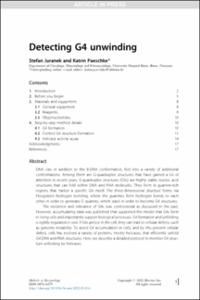Detecting G4 unwinding

Detecting G4 unwinding

| dc.contributor.author | Stefan, Juranek | |
| dc.contributor.author | Katrin, Paeschke | |
| dc.date.accessioned | 2024-04-05T11:09:19Z | |
| dc.date.available | 2024-04-05T11:09:19Z | |
| dc.date.issued | 18.04.2022 | |
| dc.identifier.uri | https://hdl.handle.net/20.500.11811/11477 | |
| dc.description.abstract | DNA can, in addition to the B-DNA conformation, fold into a variety of additional conformations. Among them are G-quadruplex structures that have gained a lot of attention in recent years. G-quadruplex structures (G4s) are highly stable nucleic acid structures that can fold within DNA and RNA molecules. They form in guanine-rich regions that harbor a specific G4 motif. The three-dimensional structure forms via Hoogsteen hydrogen bonding, where the guanines form hydrogen bonds to each other in order to generate G quartets, which stack in order to become G4 structures. The existence and relevance of G4s was controversial as discussed in the past. However, accumulating data was published that supported the model that G4s form in living cells and importantly support biological processes. G4 formation and unfolding is tightly regulated in vivo. If G4s persist in the cell, they can lead to cellular defects such as genome instability. To avoid G4 accumulation in cells, and by this prevent cellular defect, cells has evolved a variety of proteins, mostly helicases, that efficiently unfold G4 DNA and RNA structures. Here, we describe a detailed protocol to monitor G4 struc- ture unfolding by helicases. | en |
| dc.format.extent | 21 | |
| dc.language.iso | eng | |
| dc.rights | In Copyright | |
| dc.rights.uri | http://rightsstatements.org/vocab/InC/1.0/ | |
| dc.subject | G-quadruplex structures | |
| dc.subject | Helicases | |
| dc.subject | G-quadruplexes | |
| dc.subject | Guanine tetrads | |
| dc.subject.ddc | 570 Biowissenschaften, Biologie | |
| dc.subject.ddc | 610 Medizin, Gesundheit | |
| dc.title | Detecting G4 unwinding | |
| dc.type | Arbeitspapier | |
| dc.description.version | acceptedVersion | |
| dc.publisher.name | Elsevier | |
| dc.publisher.location | New York, NY | |
| dc.rights.accessRights | openAccess | |
| dcterms.bibliographicCitation.volume | 2022, vol. 672 | |
| dcterms.bibliographicCitation.pagestart | 261 | |
| dcterms.bibliographicCitation.pageend | 281 | |
| dc.relation.doi | https://doi.org/10.1016/bs.mie.2022.03.034 | |
| dcterms.bibliographicCitation.journaltitle | Methods in Enzymology | |
| ulbbn.pubtype | Zweitveröffentlichung |
Files in this item
This item appears in the following Collection(s)
-
Publikationen (4)




